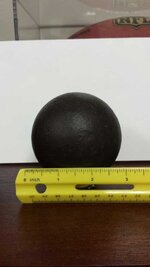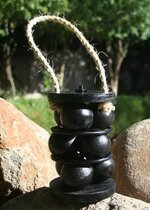Good morning-
I am new so please be gentle. I have a possible cannonball my father told me he received from a surveyor in the 1960's who was doing work near the present day Astrodome in Houston, near South Main or San Felipe. Does not appear that santa anna made his trek in that area. If it is a cannonball, maybe someone jsut dropped it. Hope somone might be able to positively id, know the time era in general, and if it might have value.
It appears to be 3 inches in diameter, made of steel, and weigh 1 pound. No holes for powder.
Thank you for your insight and thoughts in advance.
Regards
I am new so please be gentle. I have a possible cannonball my father told me he received from a surveyor in the 1960's who was doing work near the present day Astrodome in Houston, near South Main or San Felipe. Does not appear that santa anna made his trek in that area. If it is a cannonball, maybe someone jsut dropped it. Hope somone might be able to positively id, know the time era in general, and if it might have value.
It appears to be 3 inches in diameter, made of steel, and weigh 1 pound. No holes for powder.
Thank you for your insight and thoughts in advance.
Regards







